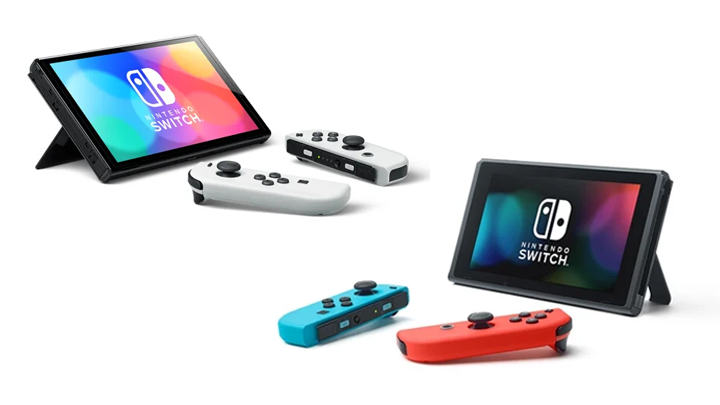Nintendo recently announced its newest model for the Switch console called the Nintendo Switch OLED. Nintendo released its original Switch console back in 2017, followed by its smaller model, the Switch Lite, then recently revamped the original with a better CPU and battery. The year 2021 greets Nintendo fans with the newest model sporting an OLED display. You may already have one, but the question stands “Should you upgrade?” Find out here as we delve into this.

Table of Contents
Just like in its name, the new Nintendo Switch OLED has an OLED display—surprise! On the other hand, the original Switch Console has an LCD screen. The basic difference is that OLED displays generate their own light and individually light each pixel, providing vivid images and better contrast. LCD uses a backlight or reflector to produce its images.
OLEDs’ advantage over LCD is that they are more energy-conservative, especially when displaying dark images—switching that pixel off if it is a dark image. So you get deeper blacks and an energy conservative device. On the flipside, LCD screens tend to last longer, as they don’t suffer color degradation that happens to OLEDs due to their organic material.
In addition, the Nintendo Switch OLED has a larger 7-inch screen while the original Nintendo Switch sits on a 6.2-inch screen. As for the topic of resolution, both devices remain at a 1280 x 720 when in handheld mode, but the OLED is capable of displaying a 1080p resolution when docked to a TV. A big ‘F’ for those who were expecting a 4K console—we are still waiting for the Nintendo Switch Pro announcement.

Upfront, the design between these two consoles are similar, same button layout and the same Joy-Cons. The difference with the OLED is the available color it comes in, White. Presenting an elegant and clean design for those people with an all-white gaming den aesthetic, or at least the preference for the color white. Not to worry, the OLED model does come in the iconic Nintendo Red and Blue colors.
If looked closely, the OLED model does have thinner bezels providing a more seamless look to it—enhancing the handheld experience. In addition, the Nintendo Switch stand has been improved, running the stand throughout the back. Thus, making it secure and adjustable for those who use its tablet mode quite often.
As for its dock, the Nintendo Switch OLED comes with an Ethernet (LAN) port, allowing a direct internet connection to the console, which is a good addition to my book, especially when WiFi is slow. No more lagging in Smash Bro fights—huzzah!
Note that both consoles are similar in hardware, both sporting an NVIDIA Tegra processor, which means they will run games similarly. However, the OLED model has an increase of internal storage at 64GB while the original version has 32GB of storage, so that’s another point for the OLED model. Nintendo also advertises that it has enhanced audio for its OLED model, providing a better audio experience in table mode.

In the battery category, the Nintendo Switch OLED model and the original Nintendo Switch will be providing the same performance. Giving users approximately 4.5 – 9 hours of playtime. Its charging rate is also similar at 3 hours of charging when the hardware is in sleep mode.
The original Nintendo Switch is priced at PHP ?15,395.00 at Datablitz however the OLED model is priced at PHP 24,995USD 426INR 36,108EUR 406CNY 3,102 .
According to the official Nintendo website, the OLED model is priced at USD 349.99PHP 20,539INR 29,662EUR 333CNY 2,547 while the vanilla model is at USD 299.99PHP 17,605INR 25,424EUR 286CNY 2,183. Note that the Nintendo Switch OLED will be officially released on October 8.
Should you upgrade?
If you already have the previous model, the short answer would be no. It is the same under the hood, same battery life, and same functionalities. The answer changes if you are going to buy a new one, for an extra USD 50PHP 2,934INR 4,237EUR 48CNY 364, you get a better and bigger screen, sturdier stand, enhanced audio, more internal storage, and an ethernet port. So if you have the means to go for the Nintendo Switch OLED, go right ahead, but if you have the original Switch, better stick to it until the Nintendo Switch Pro comes around.
So what do you think? Let us know your thoughts in the comments below. And if you want to read up more about the Nintendo Switch Pro, you can check out our article on it here.

YugaTech.com is the largest and longest-running technology site in the Philippines. Originally established in October 2002, the site was transformed into a full-fledged technology platform in 2005.
How to transfer, withdraw money from PayPal to GCash
Prices of Starlink satellite in the Philippines
Install Google GBox to Huawei smartphones
Pag-IBIG MP2 online application
How to check PhilHealth contributions online
How to find your SIM card serial number
Globe, PLDT, Converge, Sky: Unli fiber internet plans compared
10 biggest games in the Google Play Store
LTO periodic medical exam for 10-year licenses
Netflix codes to unlock hidden TV shows, movies
Apple, Asus, Cherry Mobile, Huawei, LG, Nokia, Oppo, Samsung, Sony, Vivo, Xiaomi, Lenovo, Infinix Mobile, Pocophone, Honor, iPhone, OnePlus, Tecno, Realme, HTC, Gionee, Kata, IQ00, Redmi, Razer, CloudFone, Motorola, Panasonic, TCL, Wiko
Best Android smartphones between PHP 20,000 - 25,000
Smartphones under PHP 10,000 in the Philippines
Smartphones under PHP 12K Philippines
Best smartphones for kids under PHP 7,000
Smartphones under PHP 15,000 in the Philippines
Best Android smartphones between PHP 15,000 - 20,000
Smartphones under PHP 20,000 in the Philippines
Most affordable 5G phones in the Philippines under PHP 20K
5G smartphones in the Philippines under PHP 16K
Smartphone pricelist Philippines 2024
Smartphone pricelist Philippines 2023
Smartphone pricelist Philippines 2022
Smartphone pricelist Philippines 2021
Smartphone pricelist Philippines 2020